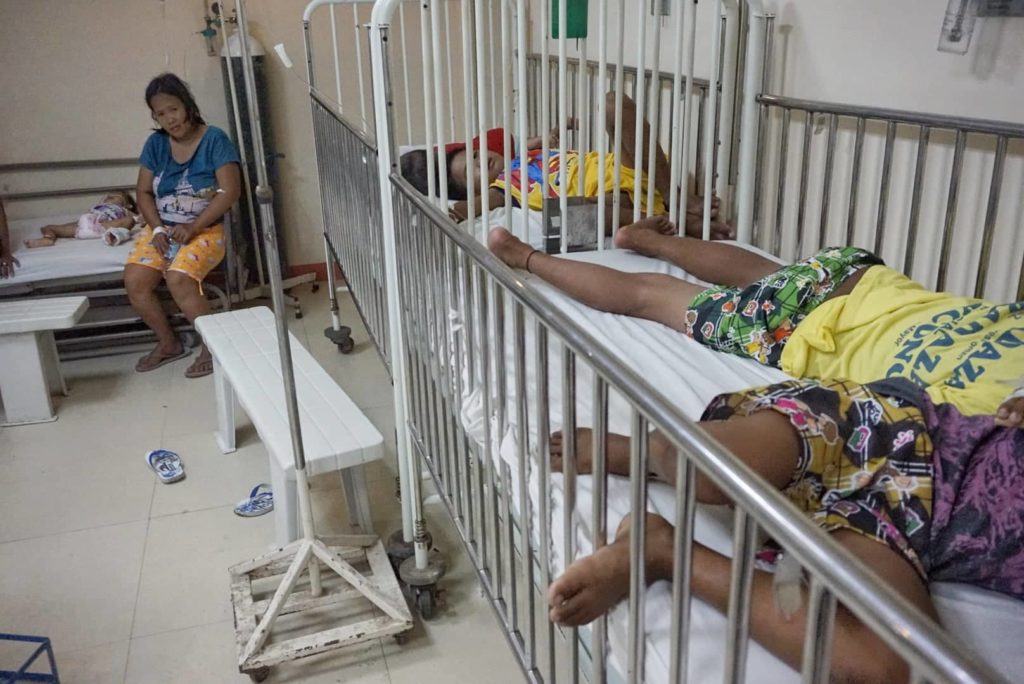VSMMC doctors look at causes other than pufferfish in the food poisoning of 8 family members

LOOK: Margie Casiao watches over her children who were admitted at the Vicente Sotto Memorial Medical Center (VSMMC) on Wednesday, March 27, 2019, due to food poisoning. CDN Digital photo | Tonee Despojo
CEBU CITY, Philippines – The Casiaos, a family of nine living on the coasts of Pangan-an, an islet-barangay located four kilometers south of Olango Island, survive each day by harvesting seafood such as crabs and fishes from the sea.
And more often than not, they catch and cook pufferfish, locally known as tikong (also called butete or burereng) as their meal.
Pufferfish is a poisonous type of fish commonly found in tropical seas. But in the hands of a skilled cook who knows how to extract its venomous sacs without contaminating the fleshly portions of this fish the size of a child’s thumb, it is also a delicacy among Cebuanos.
The Casiaos must have eaten inun-unan nga burereng (pufferfish stewed in vinegar) numerous times. But on on Tuesday, March 26, all but one suffered food poisoning after consuming pufferfish stew. It also claimed the life of the Casiao’s five-year-old son.
Doctors from the Vicente Sotto Memorial Medical Center (VSMMC) are now conducting an investigation to determine how and why the Casiaos suffered food poisoning, especially after eating pufferfish.
READ MORE: Was Olang food poisoning incident due to pufferfish?
Maeanwhile, the Casiaos are now asking help from concerned citizens for the full recovery of their five children, ages 12 to two, who are now confined in VSMMC for treatment.
What happened?
Based on data gathered by attending physicians of VSMMC, the Casiaos were admitted at the Santa Rosa District Hospital, located in Barangay Santa Rosa in Olango Island, on Tuesday evening, March 26.
The family complained of vomiting, dizziness, and abdominal pain – symptoms of food poisoning – after consuming pufferfish they harvested from the seas around Barangay Pangan-an.
But before the Casiaos got admitted in the Santa Rosa District Hospital, one of them already died back home.
Hours later, they were referred to VSMMC for further treatment. The Casiaos arrived in VSMMC in Cebu City early morning on Wednesday, March 27.
Dr. Ramon Najarro, acting medical chief of VSMMC, said it is not yet absolute if the food poisoning that afflicted the Casiaos was caused by ingesting pufferfish.
Samples of blood components from each member of the family were extracted, and sent to the toxicology center of the Department of Health (DOH) in Metro Manila for analysis.
Najarro said the Casiaos claimed they have been previously eating burereng, and that in those instances, there were never any sign of food poisoning..
As a result, attending physicians decided to entertain other possibilities that could have caused food poisoning in the family.
Theories
Dr. Beethoven Bongon, toxicologist of VSMMC, said there is a possibility that the food poisoning was due to improper food handling.
“The pufferfish they ate was caught the night before they cooked and ate it. Maybe it could be improper food handling and storage, and that bacteria have already contaminated the fish,” said Bongon.
Bongon said people who suffer food poisoning due to consumption of pufferfish will start showing symptoms such as dizziness and abdominal pain around 30 to 45 minutes after ingestion.
He said the case of the Casiaos was different.
“In typical pufferfish poisoning, the symptoms start to manifest around 30 to 45 minutes since ingestion. Although the symptoms (of typical pufferfish poisoning) are the same, but this family’s case is different,” said Bongon.
“They said they ate the pufferfish for breakfast, around 6 a.m. on Monday (March 26) but they started suffering symptoms of food poisoning around six to seven hours later, at 1 p.m.,” he added.
Bongon also said the food poisoning could also be caused by other factors such as the fact that the Casiao family also ate small crabs, locally known as kasag, together with their pufferfish stew.
“Maybe (the kasag) they ate was not properly cooked. This is why we have to conduct further tests and examination,” he added.
According to Bongon, pufferfish contain toxins called tetrodotoxin which, if ingested, can attack the neurological system of a human being, usually manifested through numbness and severe paralysis in different parts of the body.
He said there is no antidote for tetrodotoxin.
But patients eat activated charcoal or undergo gastric lavage, a gastrointestinal decontamination technique designed to empty the stomach from toxic substances, within 60 minutes of ingestion to eliminate tetrodotoxin.
Help Needed
The Casiaos have seven children, and only the eldest – a 15-year-old girl – was not able to eat the pufferfish and the only one who showed no symptom of food poisoning. The rest of the surviving children, ages 12 to two years old, are now in stable condition but still confined in VSMMC.
The parents, on the other hand, asked permission from physicians to be discharged to attend to their children now admitted in the pediatrics ward, and to process the burial of their five-year-old child.
Margie, the 36-year-old mother, is unemployed, and usually assists her husband, a fisherman, in selling their catch or takes care of their children.
Margie said they need blood donors for their two-year-old daughter who is not only suffering from food poisoning but also anemia.
She added that she feared that the recent incident that fell upon their family could aggravate the condition of her youngest child.
“This is why I’m asking anyone kind enough to donate blood for my youngest daughter,” Margie said. / ###
Disclaimer: The comments uploaded on this site do not necessarily represent or reflect the views of management and owner of Cebudailynews. We reserve the right to exclude comments that we deem to be inconsistent with our editorial standards.
